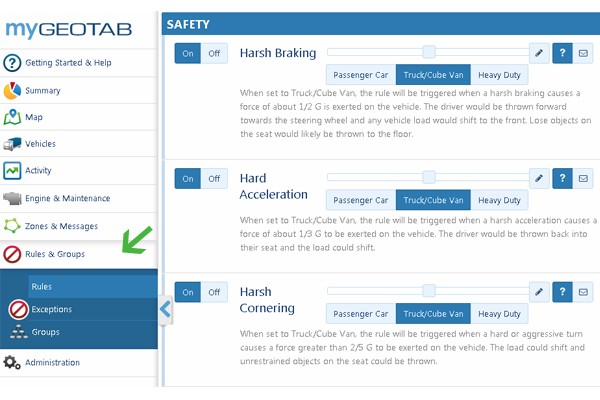Fleet Management With Advanced Exception Reporting Technology
Advanced Exception and Risk Management Reports Assist in Fleet Management
Rule Creation
A simple and effective way to manage the weak areas of a fleet is reporting by exception. Management can easily choose and set specific rules and standards by using Geotab’s Rules engine. Driver training programs that make use of the in-vehicle beeping function, which is triggered when a rule is broken, has proven to be one of the most effective ways to manage and improve the on-road behavior of your drivers.
The most common exceptions include:
- Idling over your threshold
- Speeding over the posted limit
- Seatbelt
- Aggressive driving
When these rules are broken, they can be communicated in a few different ways:
- Real-time email alert
- Urgent pop-up on screen in real-time
- In-vehicle beep can be set, this is a real-time driver behavior management tool used to correct poor driver behavior
- Possibly the most used: when rules are broken they automatically populate into the Risk Management Report and Exceptions Report. Broken rules can also show on the map for a quick view, and exact location of an incident.
What is the Different Between Risk Management and Exception Reports?
One of the biggest differences is that the Exceptions report shows the location of where each rule was broken. This data is usually most important for organizations because it encompasses all the weak spots and can be communicated to management easily when broken. It optimizes the “no news is good news” saying: management only needs to be notified if a rule has been broken.
On the other hand, the Risk Management report shows how many rules were broken and the total miles driven for the specific time frame chosen. This is also a very important metric, when you take a look over the entire organization you can see how many rules were broken over a standard amount of miles. For example how many rules were broken per 100 miles driven? This allows all drivers to be placed on an even field so the organization can enforce fair practices. Consider this: A driver that breaks 10 rules and drives 50 miles is very different than a driver that breaks 10 rules and drives 500 miles.
Want to improve fleet management and/or learn more about GPS fleet tracking and how it can optimize your business? Contact us!
Original Article From Geotab:

